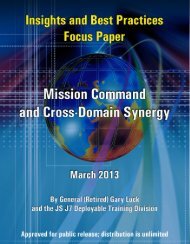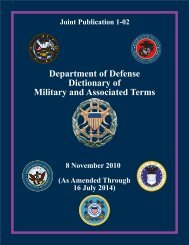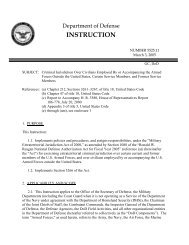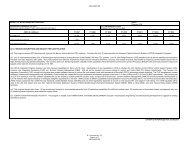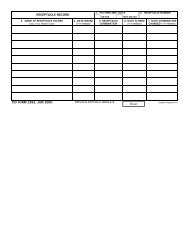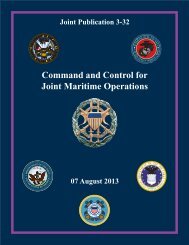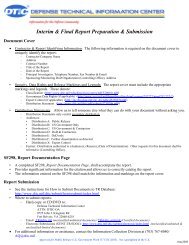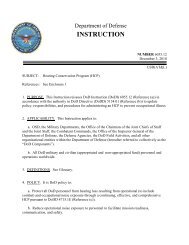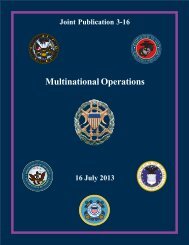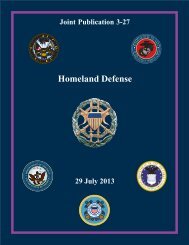JP 1, Doctrine for the Armed Forces of the United States - Defense ...
JP 1, Doctrine for the Armed Forces of the United States - Defense ...
JP 1, Doctrine for the Armed Forces of the United States - Defense ...
Create successful ePaper yourself
Turn your PDF publications into a flip-book with our unique Google optimized e-Paper software.
Chapter V<br />
can make timely and effective decisions to get inside <strong>the</strong> adversary’s decision and execution<br />
cycle. Doing so generates confusion and disorder and slows an adversary’s decision making.<br />
The commander who can ga<strong>the</strong>r in<strong>for</strong>mation and make better decisions faster will generate a<br />
rapid tempo <strong>of</strong> operations and gain a decided advantage. Consequently, decision-making<br />
models and procedures must be flexible and allow abbreviation should <strong>the</strong> situation warrant<br />
it. Adoption <strong>of</strong> a decision aid <strong>of</strong>fers <strong>the</strong> commander and staff a method <strong>for</strong> maintaining SA<br />
<strong>of</strong> <strong>the</strong> ongoing operation as well as identifying critical decision points where <strong>the</strong><br />
commander’s action may be required to maintain momentum.<br />
(6) Coordination Mechanisms. Coordination mechanisms facilitate integration,<br />
synchronization, and synergistic interaction among joint <strong>for</strong>ce components. Coordinating<br />
mechanisms can include: agreements, memoranda <strong>of</strong> understanding, exchange and/or liaison<br />
<strong>of</strong>ficers, direct and integrated staffing, interoperable communications systems, in<strong>for</strong>mation<br />
sharing, exercises, and plan development. Integration is achieved through joint operation<br />
planning and <strong>the</strong> skillful assimilation <strong>of</strong> <strong>for</strong>ces, capabilities, and systems to enable <strong>the</strong>ir<br />
employment in a single, cohesive operation ra<strong>the</strong>r than a set <strong>of</strong> separate operations. A<br />
synchronization matrix may be employed to visually portray critical actions that must be<br />
accomplished by multiple elements <strong>of</strong> <strong>the</strong> joint <strong>for</strong>ce. Coordination is facilitated through <strong>the</strong><br />
exchange <strong>of</strong> liaisons and interoperable communications systems. These mechanisms provide<br />
<strong>the</strong> JFC with a linkage to <strong>the</strong> joint <strong>for</strong>ce staff and subordinate commands’ activities and work<br />
to execute plans and coordinate changes required by <strong>the</strong> unfolding situation. In interagency<br />
and/or multinational environments where unity <strong>of</strong> command may not be possible, unity <strong>of</strong><br />
ef<strong>for</strong>t may be achieved through effective coordination, exchange <strong>of</strong> liaisons, and<br />
interoperable communications and/or common operating systems. Constant vertical and<br />
horizontal coordination and cooperation between <strong>the</strong> CCMD and component staffs and o<strong>the</strong>r<br />
CCMDs are prerequisites <strong>for</strong> ensuring timely command awareness.<br />
(7) Battle Rhythm Discipline. A command headquarters battle rhythm is its daily<br />
operations cycle <strong>for</strong> briefings, meetings, and reporting requirements. A battle rhythm is<br />
essential to support decision making, staff actions, and higher headquarters in<strong>for</strong>mation<br />
requirements and to manage <strong>the</strong> dissemination <strong>of</strong> decisions and in<strong>for</strong>mation in a coordinated<br />
manner. A defined battle rhythm should be based on <strong>the</strong> in<strong>for</strong>mation requirements <strong>of</strong> <strong>the</strong><br />
CCDR, subordinates, and senior commands. It must be designed to minimize <strong>the</strong> time <strong>the</strong><br />
commander and key staff members spend attending meetings and listening to briefings; it<br />
must allow <strong>the</strong> staff and subordinate commanders time to plan, communicate with <strong>the</strong><br />
commander, and direct <strong>the</strong> activities <strong>of</strong> <strong>the</strong>ir subordinates. The battle rhythms <strong>of</strong> <strong>the</strong> joint<br />
and component headquarters should be synchronized and take into account multiple time<br />
zones and o<strong>the</strong>r factors. O<strong>the</strong>r planning, decision, and operating cycles or processes<br />
(intelligence, targeting, and air tasking order) influence <strong>the</strong> joint <strong>for</strong>ce headquarters battle<br />
rhythm. Fur<strong>the</strong>r, meetings <strong>of</strong> <strong>the</strong> necessary staff organizations must be synchronized.<br />
Consequently, key members <strong>of</strong> <strong>the</strong> joint <strong>for</strong>ce staff, components, and supporting agencies<br />
should participate in <strong>the</strong> development <strong>of</strong> <strong>the</strong> joint <strong>for</strong>ce headquarters battle rhythm. Those<br />
participants must consider <strong>the</strong> battle rhythm needs <strong>of</strong> higher, lower, lateral, and adjacent<br />
commands when developing <strong>the</strong> joint <strong>for</strong>ce headquarters battle rhythm.<br />
(a) Simple, focused displays <strong>of</strong> in<strong>for</strong>mation delivered in a disciplined way are<br />
necessary. In<strong>for</strong>mation displayed or discussed should be mission-related. The attention <strong>of</strong><br />
V-16 <strong>JP</strong> 1



